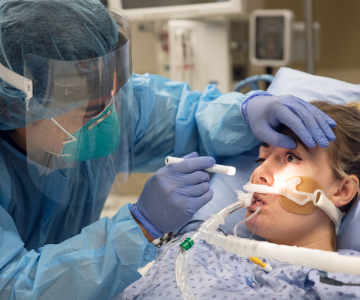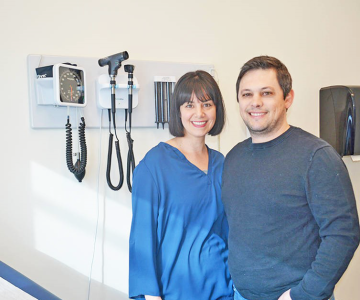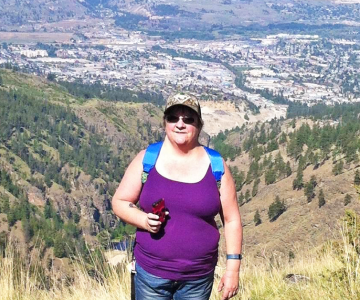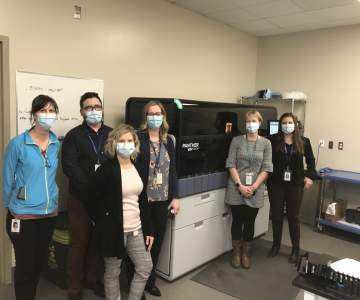Breadcrumb
Explore Stories
3 Minute Read
Community & Culture
Kamloops is a city known for year-round adventure, culture, a supportive community and a healthy lifestyle. It's also home to a brand new and state-of-the-art Patient Care Tower at Royal Inland Hospital set to open its doors in summer 2022.
The tower will include the latest technology for physicians, employees and patients to provide the best in patient care. This expansion brings a broad range of job opportunities including high acuity and specialty positions that a tertiary hospital provides while serving a large and diverse population.
The new hospital tower was designed from a patient-centred and elder-friendly perspective, with extensive input from hospital staff, physicians, and stakeholders, Thompson Regional Hospital District, the Royal Inland Hospital Foundation, and the Tk’emlúps te Secwe̓pemc.
"The next couple of years at Royal Inland Hospital are going to be truly miraculous. Adding on the new surgical tower, with private rooms, much more patient-centred opportunities for care, the team at fingertips for patients, physicians, nurses, allied health, lab, x-ray, pharmacy, you name it, all working with the highest technology to be fast, efficient and safe. The quality of care for the patients is going to be exceptional."-Mandy, Regional Practice Leader of Allied Health at Royal Inland Hospital
Dr. A Porter, Operating Room Surgeon at Royal Inland HospitalThe expansion to Royal Inland Hospital includes the latest health-care technology, featuring a rooftop helipad for emergencies, single-patient rooms to enhance patient privacy and infection prevention. This modern design provides overall bigger spaces for patients, staff, physicians, and families.
In addition to technological efficiencies, the hospital will provide inclusive spaces for staff and patients alike. Under the guidance of an Aboriginal Patient Navigator, the hospital’s sacred space allows patients of all cultures and backgrounds a safe space to practice their customs they associate with health and healing.
"What I love about my work is the cultural agility that we experience and the curiosity around culture and spiritual care." -Debra, Aboriginal Patient Navigator (APN) at Royal Inland Hospital
Kamloops is a short drive to world class skiing and is home to those who enjoy a healthy lifestyle in the outdoors with access to hiking and mountain biking trails surrounded by more than 100 lakes for fishing and water sports.
"There aren't too many places on earth wherein April you can be up snowboarding powder and then come down in the afternoon mountain biking right here in town."- Tom, Registered Nurse in Intensive Care at Royal Inland Hospital
Sun Peaks Resort. Photo provided by TNRD.
"Being in Kamloops there is a certain sense of community that can only be afforded by living in a city like this. It’s an amazing place to be. I’ve been offered so many great opportunities in this hospital and there is so much support mentorship and support."- Noah, Critical Care Registered Nurse at Royal Inland Hospital
If you're a health-care professional or just exploring health-care education opportunities, the Patient Care Tower at Royal Inland Hospital could be the next move in your medical career. Embark on your next career journey and apply at Interior Health today.
Stay updated with careers at Interior Health
@IHJobs | @InteriorHealthBC.Careers | @InteriorHealthAuthority
4 Minute Read
Community & Culture
We are IH is a recognition campaign to spotlight Interior Health employees and medical staff – through pictures and stories.
Name: Dr. Johann Schreve
Worksite: Vernon Jubilee Hospital, Okanagan / Sylix Nation
Years of Service: 5
Job Title: Hospitalist
Quote: "Seize the day, carpe diem"
Dr. Schreve's positive outlook on life, innovative mindset, curiosity, and passion to fix the world started at a young age.
His all-encompassing adoration to help others was inspired by his father, an accomplished and respected medical doctor. Growing up in a small farm community in Ceres, South Africa, it was instilled in Dr. Schreve to support and take care of your community. He has put helping others at the forefront of his life and throughout his career. With a genuine interest in people and understanding their problems, he takes the time to listen to his patients and provide valuable guidance that allows them to positively change their life.
Originally passionate about psychology, Dr. Schreve integrated his passion for mental health into his practice as a medical doctor. This personable perspective has lead to many innovative advances in his work and the communities he has served.
Passionate about technology, efficient tools, and processes, Dr. Schreve's creative and divergent thought methods have led to many technological advances in the medical field. As an integral member of the Patient Quality Improvement (PQI) Initiative, he combines his love of helping people and technology to streamline electronic documentation for medical records. This initiative is creating a standard for medical professionals to lead quality improvement projects and enhances the delivery of quality patient care.
One of his proudest moments at Interior Health was being recognized for thinking differently by the Chief Information Medical Officer and Vice President, Mike Ertel, for his innovative approach to documenting patient information enhancing patient care.
Born in Windhoek, Namibia, his family relocated to Ceres, South Africa, and he was raised in a tight-knit community, where everyone knew each other. His great love story began in Grade 1 when he met the love of his life. Their friendship evolved over the years into a romance at the age of 17. Fast forward to today, they have built a life of their own and extended their family to four kids under the age of 12. After moving his family to Canada in 2013, first to Chetwynd, B.C., followed by Williams Lake, they have now put down roots in Vernon, where they are close to their family.
Living in Vernon in the Okanagan fondly reminds him of Stellenbosch, South Africa, also located in wine country, where the people are enthusiastic about leading a fulfilling life. As a nature lover, he recently has taken up cross-country skiing, where the whole family can explore the beautiful outdoors together. He is looking forward to taking his above-average golf game to the course where he can connect with his friends and colleagues.
Understanding the importance of physical activity, getting out in nature, and taking time for yourself, he practices what he preaches. The four-season lifestyle in the Okanagan allows him the opportunity for work-life balance and a place where his children are receiving exceptional education.
In light of the COVID-19 pandemic, Dr. Schreve is reminded of his time responding to the HIV/TB pandemic in South Africa. He is proud to be a part of Interior Health, which he believes is doing a remarkable job managing public health and keeping hospitals open to the public. The pandemic has created a shift in care to a virtual approach, where it has created ease of access to care for his patients. The reach for care has extended to outlying communities allowing him to effectively reach and help more people.
A positive outcome of the pandemic is moving virtual care forward and inspiring Dr. Schreve to embark on a new journey. Joined by the University of British Columbia community of Individualized Personalized Therapeutic Nutrition, he is working towards diabetes prevention, alongside approximately 3,000 international members who are communicating on the reversal of diabetes.
His own lifestyle practice Afya Wellness launches in April of this year to bring an interactive approach to internal medicine encouraging patients to lead a healthy lifestyle for diabetes management or reversal. In alignment with his inspiration to become a medical doctor, this new venture allows him to work within his passion of helping people change their lifestyles.
Dr. Schreve's funny, kind and caring personality has a positive impact on both his patients and colleagues at Vernon Jubilee Hospital and across Interior Health. We are incredibly fortunate to have the experience, expertise and dedication of Dr. Schreve on our team, providing exceptional patient care. Thank you for all that you do for our communities, Dr. Schreve!
Nominate your colleagues to keep the We Are IH loop going: Name: Dr. Travis Allen Message: "Dr. Travis Allen does a lot for our service. He is a visionary, a true leader, who brings people together. He inspired me to move to Vernon. He creates a positive culture in the hospital."
For more information contact EmployeeExperience@InteriorHealth.ca.
5 Minute Read
Health & Wellness
There is a misconception among people, that aerosol that results from vaping, is only water vapour. In reality, vaping heats a liquid that produces an aerosol, which contains many of the same chemicals as tobacco smoke like heavy metals, carbonyls, and volatile organic compounds (VOCs). These toxic chemicals may cause cancer, lung disease, and heart disease.Youth are especially susceptible to the negative effects of nicotine which can affect memory, concentration, and their alter brain development. Damage done by smoke, to people who smoke and vape – even younger people - makes it easier to get many lung illnesses. This may put them at risk for serious complications if they get COVID-19. If you do smoke or vape, remember to maintain a safe physical distance. Stay at least two metres (six feet) apart if smoking or vaping in a group, and smoke or vape outside instead of inside.When inhaled, diacetyl causes "popcorn lung" - a chronic disease that causes scarring in the lungs narrowing the airways, and making people cough and feel short of breathMen who smoke are twice as likely to experience impotence than those who don't smoke. Exposure to second-hand smoke is a significant factor in becoming impotent.Inhaling formaldehyde can cause symptoms like sore throat, cough, scratchy eyes, and nosebleeds. It’s also known to cause cancer of the nose and throat.Gum disease is an infection of the tissues and bones that surround and support the teeth. Smoking makes it harder for saliva to remove bacteria in the mouth, and as a result smokers have a higher chance of stained teeth, bad breath, and gum disease.Nicotine raises your blood pressure and spikes your adrenaline, which increases your heart rate and the likelihood of having a heart attack.The tobacco plant has been an integral part of Indigenous culture for thousands of years, and should be treated with great respect. It is important not to confuse traditional tobacco and its sacred uses, with commercial tobacco and the addiction epidemic we see today.E-juice or Vape Juice is made up of propylene glycol or glycerine, flavourings and often nicotine. The health implications and safety of inhaling these substances are not yet known.Kids are at higher risk of getting sick from second-hand smoke because their lungs are still developing. Kids exposed to second-hand smoke have a greater risk of getting lung infections, such as bronchitis and pneumonia. They also suffer from chronic coughing, wheezing and breathing problems, and are more likely to get asthma when exposed to second-hand smoke.Researchers say that more than 90% of lung cancers in men and at least 70% in women are directly caused by cigarette smoking. Lung cancer can also be caused by second-hand smoke. People who regularly breathe second-hand smoke have almost double the risk of getting lung cancer than people who stay away from smoke.Smoking is bad for your health, but it can also make a serious dent in your bank account. Did you know that smoking 5 cigarettes per day could cost you $1500 per year? And 10 cigarettes per day could cost you $3000 per year? Think of what you could buy with that money!Visit the Break It Off website to find out how much of your money is going up in smoke!While other chemicals primarily affect the body, nicotine affects the brain. When people use nicotine products, nicotine is quickly absorbed into the bloodstream, reaching the brain within seconds. In teens, nicotine can significantly alter brain development.Smoking and chewing tobacco are a major cause of oral cancer. Thirty-seven percent (37%) of people diagnosed with oral cancer are expected to die within 5 years after diagnosis.Psoriasis is a chronic skin problem that results in thick, white, silvery, or red patches of skin that can occur anywhere on your body. Experts believe psoriasis occurs when the immune system causes the skin to become inflamed. Smoking can make psoriasis worse.Choosing to quit smoking is a huge decision. Luckily, today there are many methods for young adults to choose from, and different apps, groups and coaches available for support. Learn more about resources available and be done with smoking and vaping at BreakItOff.caDespite efforts by health care professionals, smoking during pregnancy remains a serious public health problem. Approximately 20% - 30% of pregnant women use tobacco during pregnancy which results in serious risks for both the woman and the fetus. Smoking during pregnancy has been shown to increase risks of: low birth weight, still births, decreased fetal growth, premature births, sudden infant death syndrome (SIDS), and infertility.There is no risk-free level of exposure to tobacco smoke. It affects other adults around you, children, and pets. Long-term effects of second-hand smoke exposure increases the risk of asthma, heart disease, stroke, and many types of cancer.Smoking can cause laryngeal cancer - cancer of the larynx. The larynx connects the throat (pharynx) to the windpipe, which leads to the lungs. It is an important structure that serves three main functions - to help you breathe, swallow, and speak.Smoking can make you more prone to peptic ulcers, it makes them take longer to heal, and more likely to reoccur. Young adults are encouraged not to start vaping. There are many misconceptions about the harms of vaping and a false belief that it is safe or, at the very least, harmless. This could not be farther from the truth!Everyone will have their own experience with withdrawal symptoms. For some, withdrawal won’t feel so bad. For others, it will feel horrible. Know that these symptoms won’t last forever, and usually become less noticeable after the first 4-5 days.Inhaling smoke causes permanent damage to the lungs, making their job of circulating oxygen to the rest of the body very difficult. Chest x-rays of a smoker can help detect chronic disease, heart and blood vessel issues, and some cancers. Young people are especially susceptible to the negative effects of nicotine and other chemicals found in vaping products, such as addiction.There is a misconception that inhaling "zero nicotine" products is safe. In reality, the harmful impacts of inhaling flavouring chemicals and other additives are still widely unknown.
4 Minute Read
Research & Innovation
As we look back on 2020, we might be tempted to focus on the challenges. However, I want to take a moment to reflect on the strength and resilience demonstrated by individuals and communities as we overcame unimaginable odds together.
Our health care system, supported by outstanding teams of providers, patients and families, found new and innovative ways to provide and receive care. Our capital projects continued and new services opened to ensure more patients could access the health care services they need, closer to home.
The COVID-19 pandemic hit us hard early in the year and as new information about this novel virus came streaming in, health-care teams throughout Interior Health stepped up to rapidly adapt new processes and procedures.
A team of health-care professionals at Royal Inland Hospital shared their experience about working and adjusting to the early days of the pandemic on our News@IH website, Facing the Unknown. It was inspirational throughout these past 10 months to see the spirit of our health-care workers and physicians across the health authority.
You may need a tissue to watch as they encouraged each other on YouTube in this video, Health Care Staff Supporting Health Care Staff.
These creative efforts to keep staff and patients feeling optimistic are just a few examples of what went on consistently in the background at health care sites throughout Interior Health.
When I consider the stresses that health-care staff and physicians have endured in this pandemic, I am deeply moved and so proud of the attitude and strength of our teams who have one shared goal – to protect you and each other and to provide the best care possible.
The behind-the-scenes work included upgrading technology to provide care from a distance, opening a new emergency department at Kootenay Boundary Regional Hospital in Trail, emergency department and pharmacy renovations at the Penticton Regional Hospital, and continued construction of the new Patient Care Tower at Royal Inland Hospital in Kamloops.
Urgent primary care centres continued to open, offering access to primary care services for many patients who don’t have a primary care provider of their own and to those who needed to see a physician or nurse practitioner immediately.
Surgeries restarted in May and through the collective efforts of the entire surgical team from our physicians, to nurses, to cleaning staff and leadership staff, we have made great initial progress in catching up on the elective surgeries that were paused in March to ensure hospital beds and workers were available to handle a surge in COVID-19.
The year 2020 taught us how to work together to face challenges and you were there with us every step of the way; washing your hands like never before, staying home when you were asked, wearing masks to protect others and making huge sacrifices when you were only able to visit relatives in long-term care from a distance. We know how difficult this was for our residents and their families.
You also showed your support for our health care workers with pot banging at night, parades and beautiful hand-painted signs at our health-care facilities. We are profoundly grateful.
Now we have reached 2021 and we still have a pandemic under way, but we have renewed hope with the launch of a massive immunization program to halt the spread of the COVID-19. The fast development of a safe and effective vaccine is monumental and a credit to dedicated scientists around the world who were able to build on what is already known about vaccinations.
In Interior Health, a full-scale effort is already in progress to immunize our most vulnerable populations and the health-care workers most at risk from COVID-19. This will take place over the next three months. At the moment, COVID-19 vaccines are not available for the general public, but this will change quickly. We anticipate everyone in the B.C. Interior who wants a vaccine will have been immunized by the fall. Until then, as long as we keep each other healthy, we will soon be able to celebrate renewed connections within our homes, our communities and our health-care sites.
Thank you again for your support in 2020 and Happy New Year to you all!
3 Minute Read
Community & Culture
We are IH is a recognition campaign to spotlight Interior Health employees and medical staff – through pictures and stories.
Name: Cindy Crawford
Worksite: Trinity Care Centre, Penticton, Okanagan / Sylix Nation
Years of Service: 7
Job Title: Nursing Assistant
Quote: "We all have things going on in life - be kind."
Passionate, ambitious, and humorous perfectly describe Cindy. Living by her motto “life is too short to not enjoy as much of it as you can,” Cindy appreciates travelling and adores time spent with her adorable dog, Malachi (Mal-a-k-eye).
Longing for an occupation full of excitement, service, and fulfilment, Cindy decided to begin a new career endeavour in health care. She began as a support staff worker at Fraser Health, working within housekeeping and dietary. Eager to advance her career and implement necessary changes for patients, Cindy was determined to go back to school to become a Nursing Assistant.
In 2008, Cindy relocated to Penticton to begin her education as a Health Care Aide at Sprott Shaw College. While attending school, Cindy worked within the Housekeeping department at the Penticton Regional Hospital (PRH). She was overjoyed when she was accepted into the Activity Assistant program last year at the College of the Rockies, graduating this year.
Her admirable work ethic and compassionate nature has been prominent throughout her entire career. From day one, Cindy’s daily objective has remained the same: “I show up to work to seek the ability to make someone smile and laugh for another day.” Her co-workers appreciate her positive outlook and fun attitude that brings so much joy to the workplace.
A monumental career moment for Cindy was when she was offered the opportunity to become a facilitator for Provincial Violence Prevention. Shortly after, she received training to facilitate the Safe Patient Handling course. Cindy proudly states, “it is an honour to be able to assist my co-workers to be safe,” a true testament to her genuine character.
Cindy has held the position as co-chair on the Joint Occupational Health and Safety Committee for six years at Trinity Care Centre and takes great pride in being part of the team that keeps our workplace safe.
Cindy has been taking care of her father since her mother passed away, and finds pleasure in providing a safe space for each one of our patients. Truly a selfless, considerate and generous individual.
Thank you for all that you do Cindy, IH and Malachi appreciate you, so much!
Cindy with co-worker, Cheri at Trinity Care Centre in Penticton
Nominate your colleagues to keep the We Are IH loop going:
Name: Cheri Scroggi
Message: "She is very kind and cares, not only about her residents but also her co-workers."
For more information, contact EmployeeExperience@InteriorHealth.ca.
1 Minute Read
Health & Wellness
Olympic gold medal winner and freestyle skier Kelsey Serwa took some time last week to thank ski operators and their employees for working hard to keep us safe while we have fun this winter.
Stay safe on the hill this winter with Kelsey's tips:
Ski your local mountain and support your local businesses.
Wear a mask in the lift lines and indoors.
Keep to your bubble.
4 Minute Read
Community & Culture
We are IH is a recognition campaign to spotlight Interior Health employees and medical staff – through pictures and stories.
Name: Jessica Reimer
Worksite: Kelowna Health Services, Okanagan / Sylix Nation
Years of Service: 2
Job Title: Career Marketing Assistant
Quote: "You can't buy back your time, be present."
There is something special about Jessica. Many recognize her by her beautiful bright white smile, warm demeanour, bubbly personality, and fun attitude. Her positively infectious energy radiates through the Kelowna Health Services building when she is around.
Regularly cheerleading her co-workers on, Jess provides a creative insight into problem-solving and creating meaningful ways to attract, retain, and recognize Interior Health's employees.
Jessica Reimer with Manager, Lauren Hristoski, at Interior Health photoshoot
Jessica's strong work ethic, desire to succeed, and positive outlook have greatly contributed to her career development from a Recruitment Service Partner to her current role as a Career Marketing Assistant. Working alongside many departments such as Employee and Physician Recruitment, Employee Experience and Communications, Jessica aligns the goals of the organization to execute engaging, meaningful, and effective marketing strategies.
Born in a small farm town outside of Vancouver called Agassiz, Jess was raised with her younger sister and close to her family to be the incredible person she has become today. She began to build a life for herself in Kelowna after moving to the city in Grade 11 and graduating from the Okanagan College with her Bachelor of Business Administration with a major in Human Resources Management. The education she received and the work experience she gained during these years greatly contributed to her successful career at Interior Health.
Jessica Reimer at Okanagan College graduation with fellow Interior Health employee Ryan Lazauskas (right)
Inspired to make a positive impact in the lives of others, Jess has created a career path that allows her to use her creative design abilities and outgoing personality to connect with others on a personal level.
A proud moment for Jessica was during a video interview at Kelowna General Hospital with a Medical Lab Technologist, Mussarat, where they bonded over his life experience. Born and raised in Pakistan, Mussarat taught Jessica a few Arabic phrases and shared his journey to Interior Health. Both Mussarat and Jessica felt grateful for this special experience that moved Jessica to tears, knowing that one person and one story can be so impactful and unique. It's moments like these that confirm to Jess that she is on the right career path.
You may also recognize Jessica for her In Focus article in Kelowna Now where she opens up more about her personal and professional life.
Like many, Jessica's plans changed in 2020 with the global pandemic. After over a decade with her husband, Brad, they had planned a backpacking trip across Europe for six weeks. Unable to travel, they created new plans, starting their family. Currently awaiting her first child in February, Jess will be starting a very new exciting adventure. Congratulations, Jessica and Brad!
Jessica Reimer snowshoeing at Big White Mountain, Kelowna
An adventurer at heart, Jess is looking forward to spending more quality time with her family outdoors. She can be found snowboarding or exploring the snowy mountains on snowshoes in the winter. During the spring and summer, she spends time gardening and exploring the many opportunities the Okanagan offers. As a free spirit, she can be caught dancing in the kitchen like no one is watching, singing along to her favourite tune.
This summer Jess was able to cross an item off her bucket list with Interior Health. To promote the beautiful Okanagan, Jess played a role behind-the-scenes in planning and on-the-screen as one of the real Interior Health employees in an IH promotional video.
Jessica's kind heart opens to the people she meets in health care as she connects with different departments. Through experience, her eyes are continually opened to learning more about the complexities of health care and her gratitude for our employee's service. Inspired to recognize those employees for their hard work, Jess creatively acknowledges those employees touching the lives of many.
Thank you for all that you do, Jessica! We are so excited for you to start your family!
Nominate your colleagues to keep the We Are IH loop going:
Name: Tonia Polak
Message: "I wanted to recognize Tonia for her outstanding problem solving and managerial skills. I was very impressed by her demeanour and positivity. I don't know her personally, but if she's anything like how she is at work she would be an amazing We Are IH feature."
For more information contact EmployeeExperience@InteriorHealth.ca.
2 Minute Read
Research & Innovation
New pieces of equipment, fast track renovations and great teamwork led to a massive increase in the number of COVID-19 tests that are able to be processed at Kelowna General Hospital and Royal Inland Hospital in Kamloops.
KGH and RIH are now home to new Panther fusion instruments, laboratory machines that have increased the capacity for each hospital to perform testing on COVID-19 samples.
The new machines have increased Interior Health's ability to process samples from about 900 in a day to over 1,600, ensuring timely results even in a surge event.
With these advancements there are new career opportunities with the IH lab teams. Explore career options in IH labs here.
To make room for the new technology, renovations had to take place at both sites and a wide array of employees are credited for their perseverance to get the job done in quick order.
The KGH lab increased its size by 1,200 square feet (11 square metres). A project that normally may have taken nine months, was completed in nine weeks, to allow for the Panther.
“This is what you can accomplish when this is everyone’s top priority. It was really breaking down silos to make this happen. It was a huge feat at both sites. To see whole groups of people coming together to support the labs was amazing,” says Hope Byrne, director of lab operations for the Okanagan.
At RIH where there was already a first-generation Panther in place, renovations had to be made to a tight space to accommodate the new Panther as well as a biological safety cabinet. It came on the heels of a renovation in the micro department last year but employees were up to the challenge and new staff were trained and procedures put in place.
Among the teams that worked to bring the project to fruition were lab managers and employees, medical microbiologists, infection prevention and control, work place health and safety, capital planning and projects as well as the contractors who worked on the renovations.
“There was a big effort that went into increasing our capacity to test COVID-19 samples and making sure our communities stay safe,” says Hope. “It’s a credit to the dedication of the teams involved to provide this enhanced testing to patients in Interior Health.
Photo caption: RIH team members celebrate the opening of the new Panther Fusion testing instrument. From left to right: Attending the ribbon cutting ceremony is (L to R) Dr. Rehan, Medical Microbiologist, Deb Eckert, Operations Supervisor, Laura Smith, Tech Lead Micro, Shelley Sanders, PPL, and Lindsey Eastman.
2 Minute Read
Community & Culture
Inspired by Jerusalema Dance Challenge videos she had seen from her South African colleagues over the past year, Dr. Nerine Kleinhans, Chief of Staff at Creston Valley Hospital (CVH), spearheaded this fun challenge. All departments took part with more than 90 staff participating in the making of this video – either as dancers, extras or as the filming and production crew.
"At a time when the pressures of COVID-19 weigh heavily on all staff working in our health-care sites, this was a fun chance for the team to come together and have some laughs (and lots of fun) while highlighting their message 'We are here for you, please stay safe for us!' "
- Dr. Nerine Kleinhans, Creston Valley Hospital
Jerusalema has taken on diverse meanings for people around the world including those of celebration, unity, peace, and the desire for more. The Jerusalema Dance Challenge has been the source of hope and cheer over the last year with participants posting videos of their own following the simple dance routine to the song Jerusalema by South African DJ Master KG and vocalist Nomcebo.
Dr. Kleinhans acknowledges and is tremendously grateful for all the departments that were so keen to take part. Without their thumbs-up for making a dance video, this project would not have become a reality. Thank you to everyone at Creston Valley Hospital who took part and spread so much joy at a time when our communities need it most.
Read more about this project on the Creston Valley Advance news site.
-
Load More
Showing 558 of 678
STAY CONNECTED
Receive news and alert posts, and Stories@IH blog posts, right to your inbox!









